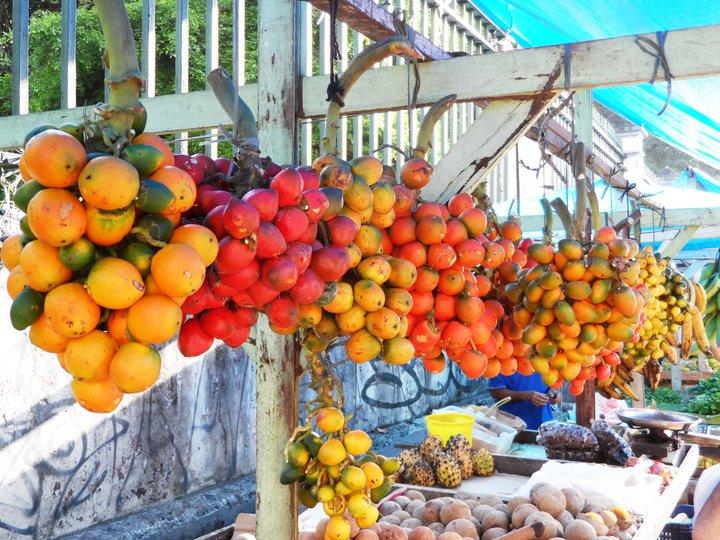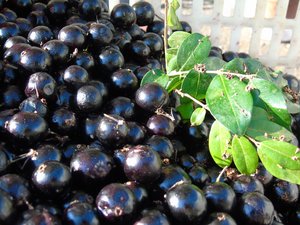Putting biodiversity back on the menu in Brazil

New Ordinance signed on Sociobiodiversity will help to increase knowledge and promote sustainable use of native biodiversity
Bioversity International Senior Scientist, Danny Hunter, together with Lidio Coradin, from the Brazilian Ministry of the Environment, talk about the importance of the first official publication in Brazil that recognizes a list of native food species with current or potential nutritional value.
Brazil has high rates of malnutrition and despite being considered megadiverse, with the world’s largest biodiversity, the country does not have more than ten consolidated native food species on the market. This is a paradox given that the country’s agribusiness is one of the strongest worldwide, but based largely on exotic species such as coffee, soy, maize, sugar cane, cotton, oranges and tobacco. Increasingly the country grows a dwindling number of species and is losing its native biodiversity even before its value and potential are realized.
In light of this scenario, a new Ordinance on Sociobiodiversity – a public policy approved by the federal government for recommendation and regulation – was signed last month by the Brazilian Ministry of the Environment and Ministry of Social Development and Fight Against Hunger. The ordinance is the first to define and support nutritionally important native species. Both Ministries consider it will help to increase knowledge and promote sustainable use of species of sociobiodiversity and its consequent conservation in Brazil.
There is a potential opportunity to restore ecosystems and foods that were once part of traditional diets, although there is a crucial gap in the knowledge base, which is the scientific information on the nutritional content of promising native food species. That is why, as part of the GEF Biodiversity for Food and Nutrition initiative (BFN), coordinated by Bioversity International, the nutritional content of more than 100 underutilized native food species is being investigated and Brazil is using information generated by the project on nutrition-rich species to inform their food and nutrition security policies.
Since 2012 Bioversity International has been working with partners in Brazil to raise awareness of the importance of biodiversity in the context of food and nutrition, and also to improve market links to ensure its uptake. This approach mainly helps to overcome the lack of appreciation of its value by both producers and consumers. “One of the achievements so far is that the program is informing public policies involved in school feeding, for example, by providing a list of nutrient-rich native species for possible inclusion in their menus and therefore in procurement. Increased purchases of these species in schools is also being monitored”, says Hunter.
 The National School Feeding Program (PNAE), one of the project’s partner initiatives, has a critical food procurement component which ensures that 30% of produce is bought from small-scale producers. This is resulting in the empowerment of producers not only through this income stream, which also pays a premium of 30% on sustainably produced local foods, but through the creation of cooperatives which often include marginalized producers, such as indigenous communities.
The National School Feeding Program (PNAE), one of the project’s partner initiatives, has a critical food procurement component which ensures that 30% of produce is bought from small-scale producers. This is resulting in the empowerment of producers not only through this income stream, which also pays a premium of 30% on sustainably produced local foods, but through the creation of cooperatives which often include marginalized producers, such as indigenous communities.
It also encourages diversified production on the farm which in turn increases resilience, for example to extreme weather events such as drought, which can destroy an entire harvest of a single crop. At the moment, the diversity count is low in terms of species being purchased through the program but this also means there is a great opportunity to monitor how increasing the diversity produced, purchased and consumed will in the longer-term improve nutrition and affect the livelihoods of the small-scale producers involved.
Lidio Coradin, consultant for the Brazilian Ministry of the Environment and Biodiversity for Food and Nutrition Project Director in Brazil, says there are several federal programs and policies being implemented, that play a decisive role in improving food, nutrition and human well-being in the country, but despite these initiatives and high available financial resources, the country still has high rates of overweight and obesity in the different layers of the population. “Unfortunately, these figures are increasing. At present, about 57% of the population suffers the consequences of overweight and approximately 21% of the population above 18 years are struggling with obesity problems. This happens mainly because of considerable reduction in the number of species that form the basis of our food, or even low consumption of vegetables and fruits in general. We need to diversify our diet and give more attention to nutritional aspects”, highlights Coradin.
The new Ordinance, published on the 18th of May 2016, is considered an important step towards promoting sustainable use of species of socio-biodiversity and its consequent conservation. These species will now be more attractive for smallholders not only to grow and conserve them, but also to use and commercialize, since they now have greater recognition by federal institutions, partners of the Biodiversity for Food and Nutrition initiative – from which sixty four prioritized species appear on the list.
Coradin still adds “this is just a starting point for a big change”. From his perspective, this formal recognition, at the federal government level, will actively promote and support the sustainable use of native species.
For more information, please contact Danny Hunter.
In 2016, a food compositional analysis will be carried out for the species targeted by the project for which nutritional data is missing or incomplete in collaboration with national research institutes and federal universities in Brazil. At the same time, through continued collaboration with the Plants for the Future Initiative, and following the book already published for the South region of Brazil, four books documenting the properties and benefits of traditional plants from the Centre-west, North, Northeast and Southeast regions of Brazil will be published. One of the next steps also is to work on a strategy for the procurement of sociobiodiversity, in order to create incentives for municipalities to buy these products and at the same time be rewarded for doing so. With the supply and demand rule, we expect more farmers will grow and conserve sociobiodiversity species. On the other hand, there is also a need to create strategies to attract farmers, especially smallholders, to the cultivation and marketing of these species by employing additional payment for the sale as an incentive.
The GEF ‘Biodiversity for Food and Nutrition’ initiative is led by Brazil, Kenya, Sri Lanka and Turkey and coordinated by Bioversity International, with implementation support from the United Nations Environment Programme (UNEP) and the Food and Agriculture Organization of the United Nations (FAO) and additional support from the CGIAR Research Program on Agriculture for Nutrition and Health.
Photo top:Pupunha bunches (Bactris gasipaes). Credit:Plants for the Future Initiative
Photo bottom:Jabuticaba fruits (Plinia cauliflora; Plinia peruviana). Credit:Plants for the Future Initiative
